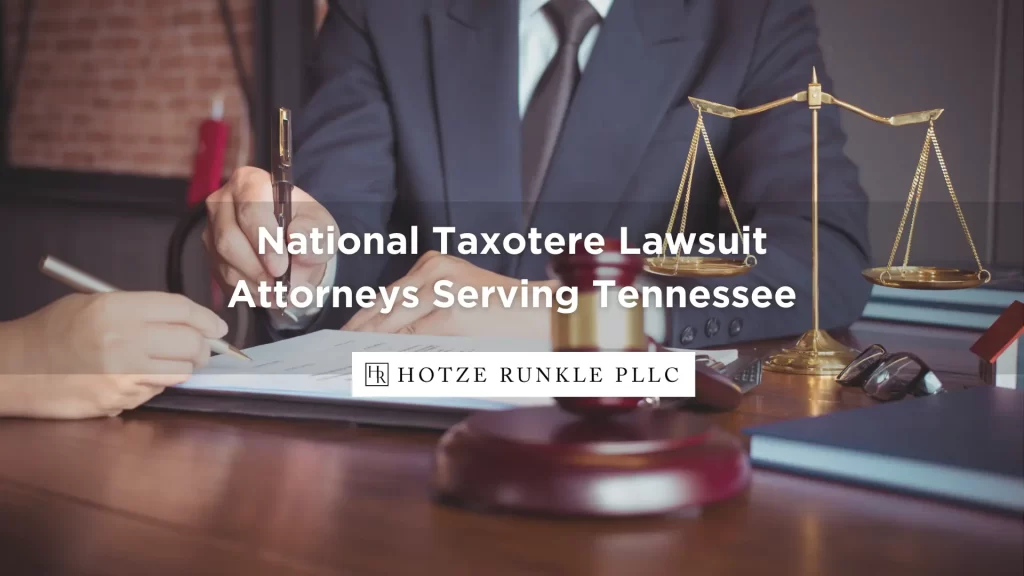
If you are experiencing symptoms of canalicular stenosis, such as unexplained eye-watering, you could be owed significant compensation. Our Tennessee Taxotere attorneys help those who’ve suffered severe eye issues due to the use of the widely-prescribed chemotherapy drug.
Watery eyes are the telltale sign of an underlying medical condition. Breast cancer survivors undergoing or completing Taxotere chemo treatment complain of similar symptoms.
Taxotere is a drug commonly used to treat breast cancer. The manufacturer, Sanofi-Aventis, developed it to prevent cancer cells from growing and spreading throughout the patient’s body. Current lawsuits against the pharmaceutical company show the severe side effects experienced by individuals taking this drug.
The various symptoms people experience range from mild to severe. For some, it’s just a minor nuisance, while others complain of the profound negative impact on their lives. The most common ocular symptoms reported include the following:
- Consistent eye-watering
- Sensitivity to light
- Headaches
- Blurry or cloudy vision
- Swollen eyelids
- Dry eyes
- Eye infections
- Excessive tears
- Vision loss
If you or someone you know took Taxotere and developed any of the symptoms above, our Tennessee Taxotere attorneys can help you get full and fair compensation.
How Does Taxotere Work?
The drug company, Sanofi-Aventis, first introduced Taxotere over 25 years ago. It’s administered during chemo treatments intravenously to shrink the patient’s cancer cells and prevent the disease from spreading. Although mainly used to treat breast cancer, it’s also known to treat cancer in the lung, prostate, stomach, head, and neck. Oncologists choose to administer the drug on a regimen tailored to each individual. Depending on the severity of the disease, you could receive treatment weekly, every two weeks, or every three weeks.
Initial studies showed the benefits of using it during chemotherapy treatments. One of the first trials demonstrated the significant improvement to overall survival rates and decreased time of disease progression in breast cancer patients.
During the trial, patients in one group received Taxotere, while patients in the other group received Taxol (another popular chemo drug). In the patients who received a one-hour intravenous dose of Taxotere every 21 days, doctors noticed higher response rates than those receiving Taxol at three-hour doses every 21 days.
The women in the study had advanced or metastatic breast cancer and prior failure trying an alternative chemotherapy regimen. After completion of the experiment, women taking Taxotere showed an overall survival of 15.4 months as opposed to only 12.7 for Taxol.
How Do I Know if Taxotere Caused My Symptoms?
Medical researchers established a link between Canalicular Stenosis and Taxotere treatment. They discovered that the secretions from the drug interact with a patient’s tears while traveling through an eye structure called a canaliculus. That direct contact causes inflammation, which leads to a blockage, preventing the tears from properly funneling through the canaliculus to the nasal cavity. With nowhere else to go, the tears get released from the eye in uncontrollable amounts.
Breast cancer survivors typically experience symptoms while they’re still undergoing chemo with Taxotere. The first symptom is epiphora (constant eye-watering). Most individuals ignore it thinking it’ll go away. However, if left untreated, it develops into the more severe Canalicular Stenosis diagnosis.
In some cases, there’s only mild irritation that causes a small blockage, which is potentially reversible. In more critical situations, the canaliculus gets blocked permanently. Unfortunately, that isn’t reversible by medications or any type of surgery. The only solution to manage the symptoms you experience is an invasive surgical procedure.
What’s the Cure for Canalicular Stenosis?
Early detection and treatment are crucial in preventing the adverse side effects from developing into a long-term diagnosis. As mentioned before, epiphora is usually the first symptom patients notice. When evaluated by an ophthalmologist, he or she could manage their watery eyes. There are also preventative measures to alleviate any inflammation and make sure any current obstructions don’t progress.
Canalicular stenosis isn’t curable. Once the vital eye structures become blocked or close completely, there’s not much a doctor could do to reverse it. An expensive and invasive ocular surgery could help to manage the symptoms. During DCR, dacryocystorhinostomy, the surgeon removes a bone from the nasal cavity to connect two structures within the eye. That allows tears to bypass the obstructed canaliculus and drain into the nasal cavity, as intended.
When performed by a licensed ophthalmologist, DCR successfully redirects tears through the appropriate channels, so they don’t exit from your eyes. However, as with any type of medical procedure, there are risks associated with DCR, including:
- Hemorrhaging during or after surgery
- Injury to the canaliculus from the incision
- Shredding of nasal structures during bone removal
- Eye infection
- Ineffective procedure
- Sinusitis
- Significant facial scarring
- Damage to surrounding tissues, resulting in blindness
In patients with advanced canalicular damage, it’s not possible to perform DCR to reroute the tears through another passageway. In those kinds of situations, CDCR, conjunctivodacryocystorhinostomy is necessary. During that procedure, a small glass tube (a.k.a. Jones tube) gets positioned where the canaliculus was to aid in the proper funneling of tears. The same risks listed above also apply to CDCR.
Can I Sue My Doctor for Prescribing Taxotere?
The short answer: probably not. Most plaintiffs in recent lawsuits received the chemo drug from physicians unaware of the potential diagnosis of canalicular stenosis. Sanofi marketed the drug for years without disclosing the negative reactions associated with the ocular condition.
In thousands of complaints filed, breast cancer survivors stated that the manufacturer knew of the potential risks from Taxotere, but failed to publish them. It wasn’t until the release of studies confirming the connection between the chemo drug and Canalicular Stenosis that the FDA finally released warnings.
Despite the apparent dangers of Taxotere treatments, Sanofi continues to manufacture and market its drug to oncologists and cancer patients around the world. False marketing campaigns and the company’s role in distributing medicine with harmful side effects are grounds for a lawsuit.
How Do I Receive Financial Compensation If I’ve Developed Canalicular Stenosis?
 When you’re getting ready to file a lawsuit, there are vital steps you should take:
When you’re getting ready to file a lawsuit, there are vital steps you should take:
- Seek Medical Treatment: Continue to attend regularly scheduled appointments with your oncologist and ophthalmologist to treat both your cancer and Canalicular Stenosis. It’s possible to continue chemo despite your new diagnosis.
- Collect Documents: Create a file with all medical records and documentation relating to your chemo treatment and the symptoms you developed.
- Evaluate Your Expenses: Round up your medical bills to determine the total number of expenses you incurred because of the side effects you experienced after undergoing Taxotere chemo treatments.
- Keep Detailed Notes: Keep a diary of relevant information, such as when your symptoms started, the treatment you sought, and any individuals who witnessed your situation.
- Seek Legal Representation: Hiring an attorney could prove beneficial in securing a fair settlement. If you’re unfamiliar with the process, you might not know what your rights are or how much compensation you deserve.
Once you retain an attorney from Hotze Runkle PLLC, we will open an investigation into your claim and gather the necessary evidence that proves Taxotere directly caused your symptoms. The lawsuits we’re handling for our clients are our attempt to show Sanofi failed its consumers by hiding the permanent side effects of their drug.
We understand the overwhelming feeling this experience caused. When you hire us, we will work diligently and efficiently to try to receive the maximum settlement available to you. You shouldn’t have to pay for any expenses related to your symptoms and the treatment required to alleviate them. It’s our goal to hold Sanofi responsible for their careless actions.
How Can Hotze Runkle PLLC help me?
We dedicate our time and attention to every client we represent. A devastating situation like this affects everyone involved. Beating cancer only to discover you’re up against a new set of obstacles is emotionally exhausting.
When you have an experienced attorney by your side, you can focus on your recovery while we handle all the legal aspects of your case. We approach every client differently to form an individualized plan that meets his or her needs. It’s our goal to seek the justice you deserve through any means possible.
At Hotze Runkle PLLC, we believe in the importance of providing excellent customer service. We treat our clients with compassion, respect, and professionalism at all times. You can depend on us to be there for you when you need us the most. When you hire one of our experienced trial lawyers, we will make you a priority. We’ll guide you through the confusing legal process and provide valuable advice along the way.
We don’t believe in adding to the burden you already face. That’s why we offer free consultations to all prospective clients. We’re happy to meet with you to review the details of your case and determine if we’re able to move forward with it.
Find out if you qualify for compensation by taking the Taxotere Lawsuit Quiz.